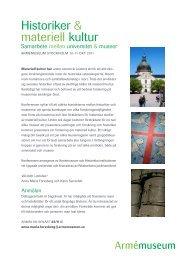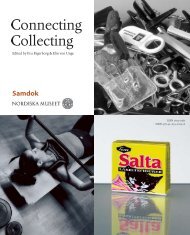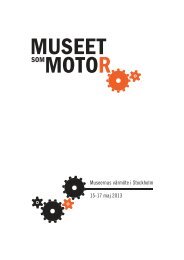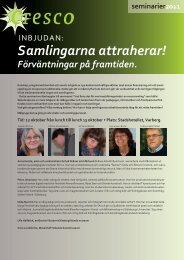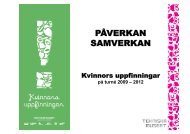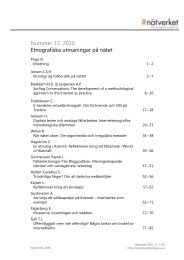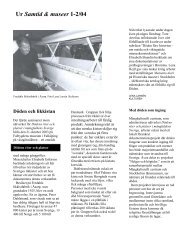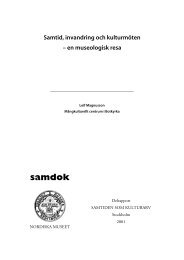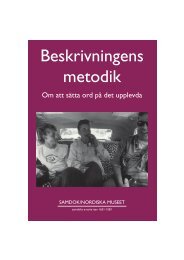Connecting Collecting - Sveriges Museer
Connecting Collecting - Sveriges Museer
Connecting Collecting - Sveriges Museer
Create successful ePaper yourself
Turn your PDF publications into a flip-book with our unique Google optimized e-Paper software.
The Pool for Local and Regional Spheresge the built environment as a mirror of the timesPetra is busy tearing down walls to create anopen plan in the family’s newly purchasedhouse. Change was the key word whenStockholm County Museum documentedBerghem, which has developed in thirty-fiveyears from being a homogeneous to a heterogeneoushousing estate. Photo: ElisabethBoogh, Stockholm County Museum.and uniqueness of the buildings. Insteadthey looked for the stories the buildingstell about a society in development andchange. The project was carried out indialogue with inhabitants of Bromölla,which gave the museum insight intoalternative ways of understanding andremembering buildings.Stockholm County Museum, togetherwith Södertälje municipality and theStockholm County Administration, havebeen working for a couple of years withthe influence of the companies Scaniaand Astra on housing in Södertälje. Inthe post-war years the companies expandedvigorously, and being able tooffer housing was a condition for thepotential to recruit both blue-collar andwhite-collar staff. The questions askedby the study concern the companies, themunicipality, and their relations, as wellas how inhabitants of Södertälje thenand now have perceived the city andits changes. Both the Bromölla and theSödertälje studies also give a local perspectiveon the grand narrative of Swedishmodernity.From group houses to detachedhousesAnother example of a study inspired bythe pool’s policy statement is StockholmCounty Museum’s study of the Berghemhousing estate in Järfälla municipality. Abuildings antiquarian and an ethnologistcollaborated in a study of the area, whichwhen it was built at the end of the 1960sconsisted of 142 identical houses of thetype known as “WP-villa”. Today mostof the houses have been transformed indifferent ways. Many have been paintedin other colours, some have been givennew roofs or entrances. In this study thequestions concerned why the houseshad changed and what this can say abouthow society has changed in the fortyyears that have passed since the firstfamilies moved in.A street in StockholmThe pool’s policy statement also declaresthat an interesting topic is how place andidentity interact. The starting point isthat the concept of identity has changedin late modern society, which meansthat given positions and identities are increasinglyquestioned. For our pool it isof particular interest to see how identityseeking and identity formulation are relatedto the spaces, or places, where thisis enacted. How, for example, do peopleclaim the public space? How are placesaffected by the individuals and groupswho use them?Some of these questions recur in theproject Götgatan, which Stockholm CityMuseum conducted during one week inJanuary 2003. The street is mentionedfor the first time in 1494, and it has followedroughly the same course sincethen. The point of departure was thatchanges in Götgatan happen simultaneouslyin several chronological layersand at different speeds. It is both representativeand specific, both generaland unique to Stockholm. It is a partof a city and it is a local whole with abeginning and an end. The documentingteam wanted to find methods thatcould shed light on changes in the streetin the course of a day and night, as wellas more lasting phenomena. They useddifferent interview techniques: one fastwith short questions for passers-by and adeeper one with some people for whomthe street was their workplace. Theyphotographed, filmed, recorded streetnoises, and made quick notes about whathappened in the street. Posters and anumber of artefacts were collected. Thegroup, which worked virtually round theclock during the week, hopes to be ableto return at regular intervals in orderto collect material reflecting the streetand changes in street life over a longerperiod.The future of the poolTo sum up, the pool has been both usefuland pleasurable for those taking partin it. Our questions have changed overthe years, and when we revised our policystatement a couple of years ago, wenoted that much of what we thought wewere alone in discussing during the firstyears were questions that are now consideredimportant in the sector. We hopein future to be able to assemble aroundjoint projects where we can sharpen ourquestions or perhaps ask completely newquestions as society changes. pBarbro Mellander is regional director ofmuseums and sites and head of RegionmuseetKristianstad and chair of the Pool for Local andRegional Spheres,barbro.mellander@regionmuseet.m.seAnna Ulfstrand is ethnologist and photographerat Stockholm County Museum and secretary ofthe pool for Local and Regional Spheres,anna.ulfstrand@lansmuseum.a.seSamtid & museer no 2/07 • 13



